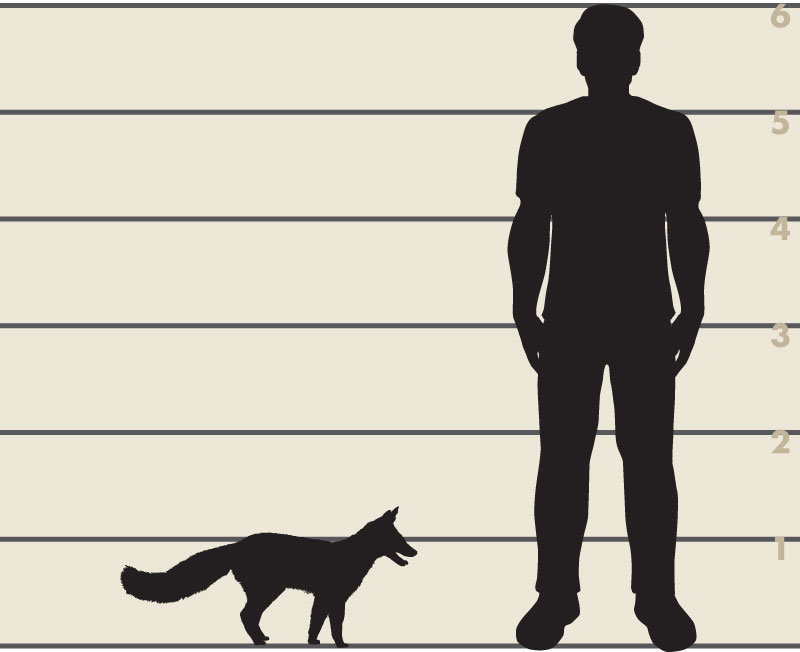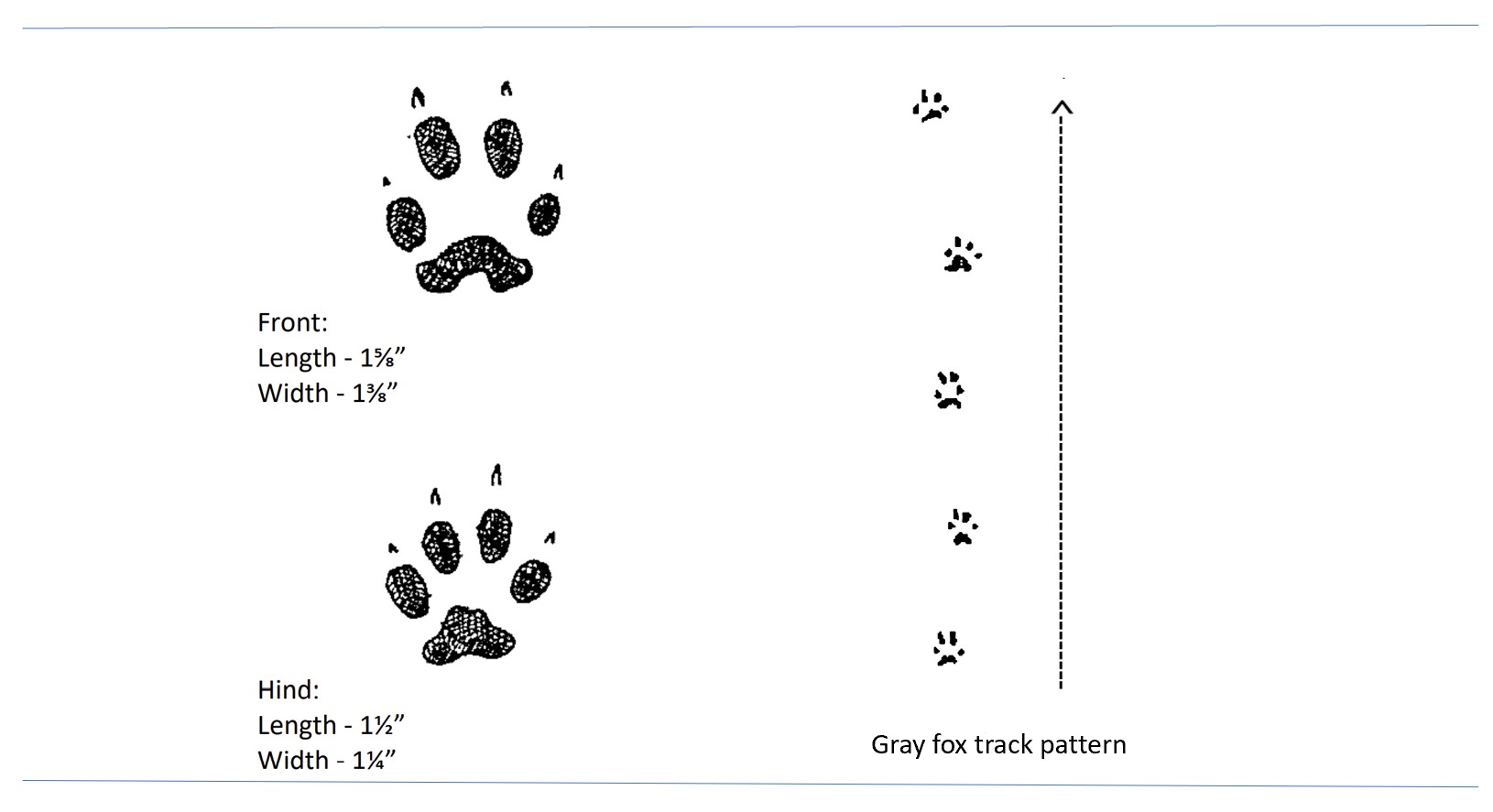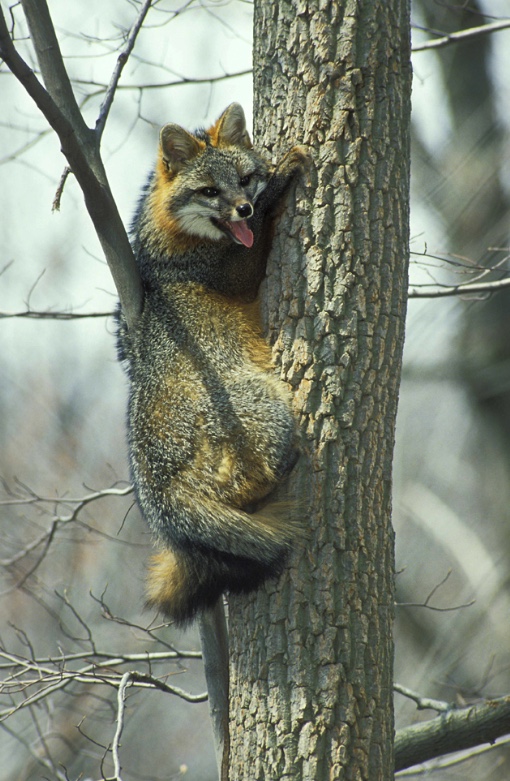
Learn more about gray foxes in Illinois in OutdoorIllinois Journal:
Gray foxes are omnivores, eating a mix of plants and animals. They help control rabbit and small mammal populations and can consume large quantities of insects during the summer.
Gray foxes are a grizzled gray color, having cream-colored fur tipped with black. The fur on their underside is light tan, often tipped with reddish fur. They have a line of black fur extending down the top of their tails to the tip. The cheeks and throat are white, with this band of light fur extending the length of the belly to the tail. The backs of the ears and the sides of their neck are a rusty orange. Gray foxes’ legs and feet can be rusty orange or grizzled gray.
Gray foxes are slightly smaller in size than red foxes, typically weighing between 7 and 14 pounds.
The tracks of gray foxes can be hard to distinguish from those of red foxes, though the gray fox leaves slightly smaller tracks. The front tracks are slightly larger than the rear tracks, measuring 1.3 to 2.1 inches long by 1.1 to 1.5 inches wide. Their hind feet have semi retractable claws, so the claw marks do not always appear on the rear tracks.
Gray fox droppings are similar to red fox droppings, resembling droppings of a small dog. The appearance of the droppings depends upon the fox’s diet and may include bone, fur, feathers, or seeds.
Gray foxes are found statewide in areas with deciduous forests. They prefer a mix of wooded and open areas to heavy forest, but they are also found on the edges of towns and subdivisions.
Gray foxes are more common in southern Illinois and in wooded areas along the Mississippi and Illinois rivers. In Illinois, they are less common than red foxes.
Gray foxes are good at climbing trees, and they often do so when they are startled or to hunt. They climb by grasping the tree trunk with their forelegs and pushing up with their hind legs.
Gray foxes are omnivores, eating a mix of plants and animals. They help control small mammal populations and can consume large quantities of insects during the summer.
They are most active at night, usually sleeping during the day in dens, dense shrubs, or hollowed trees or logs.
Gray foxes are susceptible to rabies and canine distemper, but they seem to be resistant to sarcoptic mange, which is caused by mites. They are not considered a public health threat.
Gray foxes are found in or near deciduous forests.
Gray foxes are omnivores, eating a mix of plants and animals. Rabbits make up a majority of their diet, but they also eat mice, voles, and a range of berries, fruits, and other vegetation. During the summer, fruits and insects are heavily consumed.
Gray foxes breed January through March, with a gestation period of about 53 to 63 days. Most young are born in April and May, and they are usually weaned by 3 months. Typical litters are 3 to 5 pups, which live with the male and female in family groups until the pups are about 4 months old. They are on their own after that, and females can breed by the time they are 10 months old.
Gray foxes tend to be secretive animals and do not often cause problems.
Control rabbit and small mammal populations to reduce the likelihood that a fox will use your property.
To protect poultry, make sure that fences are secure. Wire fencing should be buried at least 12 to 24 inches below ground to prevent foxes from digging underneath the fence. Wire mesh fences should have openings less than 3 inches to prevent foxes from squeezing through the fence. Since gray foxes are good climbers, it will be necessary to add a wire roof to keep determined foxes out. Providing a shed or other enclosure will help protect poultry. All doors or other openings should be shut at night. Predation of poultry occurs most frequently during late spring and summer when foxes are busy feeding their young.
There are currently no approved repellents for gray foxes in Illinois.
Frightening devices are typically ineffective at deterring foxes.
If a gray fox is taking poultry or causing other problems, they may be trapped and removed if a permit has been issued. If you want to hire someone to remove the fox for a fee, contact a nuisance wildlife control operator. If you want to trap the animal yourself, you will need a nuisance animal removal permit issued by an Illinois Department of Natural Resources district wildlife biologist. The biologist can provide information on resolving problems.
The IDNR Furbearers page provides more information about hunting and trapping Furbearers. The Illinois Trapper Education Manual provides guidance on the best management practices for trapping. Trap size recommendations for gray foxes are found on page 90; see Trapper Education Manual.
Current hunting and trapping seasons can be found in the Illinois Digest of Hunting and Trapping Regulations or in the Legal Status section below.
Recreational fur-trapping (and hunting when and where allowed) is the preferred method to deal with nuisance furbearer issues. Trapping can help control the local population of animals and, in some cases, reduce the number of nuisance complaints and the damage that some species can cause. The Illinois Department of Natural Resources offers a lengthy trapping season (3 months, in some cases 4.5 months). Legal trapping can occur 100 yards from an occupied dwelling without permission of the occupants, closer with permission as long as there are no municipal ordinances that prohibit trapping.
In Illinois, gray foxes are protected as a furbearer. If a gray fox in an urban area is causing a problem, it may be trapped and removed if a nuisance animal removal permit is issued by an IDNR district wildlife biologist. In rural areas, a trapping license is needed to harvest a gray fox. Gray foxes may be hunted or trapped from mid-November through mid-February. The Illinois Digest of Hunting and Trapping Regulations provides full hunting and trapping season dates and regulations.

Photo: Jerry Litynski

Illustrator: Lynn Smith

Illustrations: Dan Goodman

Photo: Steve Wayne, Painet Inc., IDNR image library
The Wildlife Illinois website was authorized by the Illinois Department of Natural Resources (IDNR) in partial fulfillment of project W-147-T. The website was developed by the National Great Rivers Research and Education Center, 2wav, and the IDNR in partnership with the United States Department of Agriculture Animal and Plant Health Inspection Service Wildlife Services and University of Illinois Extension to provide research-based information about how to coexist with Illinois wildlife.